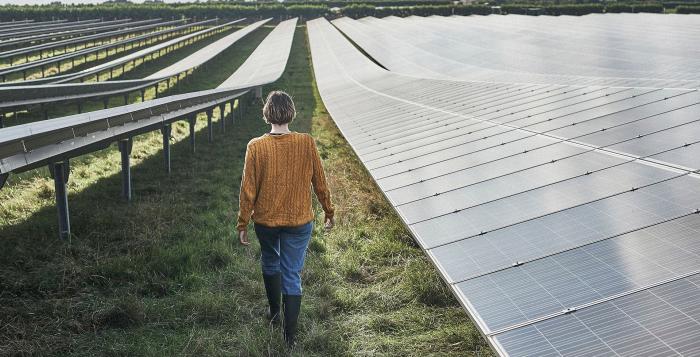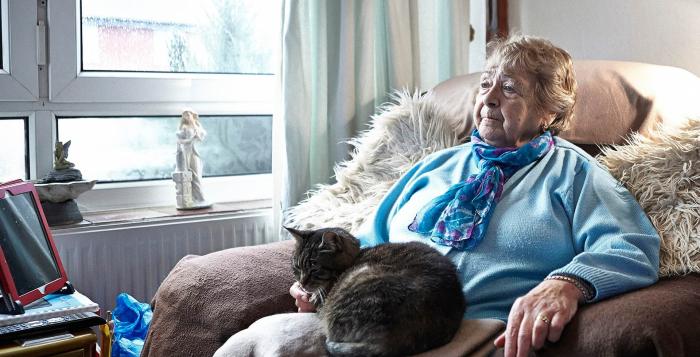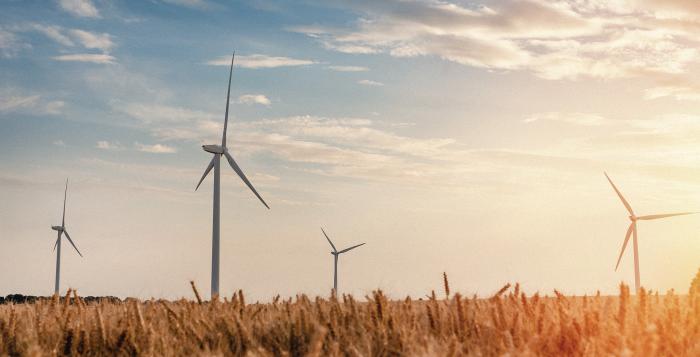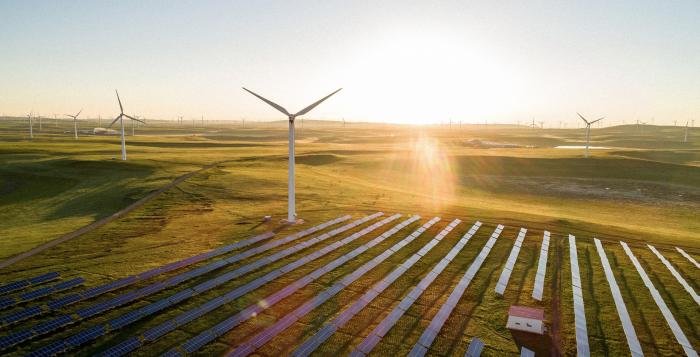FES Documents
Download our latest FES 2024 Document suite and check out the archive of older FES documents.
Download the full suite of FES 2024 documents
FES: NESO Pathways to Net Zero 2024
The Future Energy Scenarios publication presents a number of strategic and credible energy futures to support Great Britain’s decarbonisation journey to net zero.
FES: Pathways at a Glance
For faster reading, download our FES summary document, which highlights the key headlines and statistics from the full publication.
FES: Data Workbook 2024
All the graphs, charts and supporting data published in FES 2024 from our modelling. If using Microsoft Edge, you will need to download the file rather than view online.
Changes from FES 2023 to FES 2024
This document summarises the key differences between FES 2023 and FES 2024. We present a high-level summary of changes with more detail available in the main FES 2024 report.
FES: Energy Background Document
The purpose of our Energy Background Document is to provide supplementary content and background to underpin the main FES 2024 document.
FES Pathway Assumptions 2024
Find out what assumptions we used in our models for FES 2024
Regional breakdown of FES data (workbook)
FES modelling data segmented by region
Modelling Methods 2024
Learn more about the models we used to base the scenarios on.
FES: Pathway Assumptions 2024 (Workbook)
This workbook is intended to provide additional information about the main assumptions made and data used in creating the 2024 FES: ESO Pathways to Net Zero Documents and data workbook.
FES Archive
The FES archive dates back to 2011, and all of our documents are publicly available for download.
2024 archive
2024 archive
- 2024 call for evidence summary
- FES 2024 framework thought piece
- FES 2024 stakeholder feedback document
Consumer Building Blocks project
The Consumer Building Blocks innovation project, delivered alongside the Centre for Sustainable Energy and ERM, developed a model for predicting how consumers may adapt their energy consumption in a range of different factors. You can find the slides, a recording from the webinar that we hosted and the data from the project here:
2023 archive
Below you can find the 2023 FES document suite.
- FES 2023 report
- Regional breakdown of FES data (workbook)
- Regional breakdown of FES data - ETYS 2023 Appendix E
- Changes from FES 2022 to FES 2023
- FES 2023 - Data workbook
- FES 2023 Data webinar - slides
- FES 23 energy system webinar slides
- FES 2023 energy consumer webinar slides
- FES 2023 flexibility webinar slides
- FES 2023 net zero webinar slides
- FES 2023 - Presentation slides
- FES 2023 - Regional Breakdown of FES (data)
- FES 2023 - Scenario Framework and assumptions
- FES 2023 - Modelling Methods
- FES 2023 - FES in Five
- FES 2023 - Energy Background Document
Watch the FES 2023 launch event
Watch our FES 2023 launch event from the 10 July, featuring Fintan Slye, Executive Director at ESO, Emma Pinchbeck, Chief Executive of Energy UK, and Daisy Powell-Chandler, Head of Energy and Environment at Public First.
- Watch the FES 2023 launch recording
- Download the FES 2023 presentation slides
- Download the ESO exhibition stand slides
More documents
2022 archive
The Future Energy Scenarios (FES 2022) set out credible ways that the UK can achieve Net Zero by 2050, as well as the UK Government’s commitment to a decarbonised electricity system by 2035. Based on extensive stakeholder engagement, research and modelling, each scenario considers how much energy we might need; where it could come from; and how we maintain a system that is reliable.
Below you can find the 2022 FES document suite.
- Future Energy Scenarios 2022 report
- Future Energy Scenarios 2022 in Five
- FES 2022 full report - print version
- FES in Five - print version
- FES 2022 Data workbook
- FES 2022 scenario assumptions
- Regional breakdown of FES electricity data (maps)
- Regional breakdown of FES data (workbook)
- Key changes from FES 2021 to 2022
- How we do our modelling for FES 2022
You can also still watch a recording of our briefing event to mark the launch of the 2022 edition of our Future Energy Scenarios report.
Below you can find the 2021 FES document suite.
- FES 2021 full report - interactive version
- FES 2021 full report print version (non-interactive)
- FES in Five
- FES 2021 FAQs
- Data workbook
- Scenario framework
- Key changes
- Modelling methods
Our podcast series explores key themes from Future Energy Scenarios 2021, assessing the energy Britain needs, examining where it could come from, how it needs to change and what this means for consumers, society and the energy system itself.
Our latest Future of Energy podcast looks at the future of hydrogen. Hydrogen is becoming a vital source of energy, but how does it actually help us produce energy and how will it be used to replace some of our current energy sources? In this episode Samantha Simmonds talks with Becky Hart, UK Energy Strategy Manager, and Robert Gibson, Whole System and Gas Supply Manager, to find out how hydrogen is becoming the fuel of the future and how it will help Great Britain achieve its net-zero target.
Listen and subscribe
FES 2020 Virtual Conference
During the week of 27 July, we held a series of virtual events to share the key insight from our FES 2020 analysis. This included a launch on Monday 27 July to present the FES 2020 key messages and the significant findings from the analysis.
On Wednesday 29 July and Thursday 30 July, we hosted a series of deep dive sessions to look at specific topics in more detail.
You can now watch the events on catch-up.
FES 2020 Documents
All FES 2020 documents including:
FES in 5, Data workbooks, Scenario framework and Modelling methods can be found here:
- FES 2020
- FES in Five
- FES 2020 FAQs
- Data workbook
- Scenario framework
- Key changes
- Modelling methods
- Regional breakdown of FES data
Deep Dives - 29 - 30 July 2020
Watch the deep dive sessions including a series of short presentations followed by Q&A time with the team.
Call for Evidence for Future Energy Scenarios (FES) 2019
Throughout September, we ran a Call for Evidence as a start to our work for FES 2019. We wanted to provide ample opportunity for our growing stakeholder base to engage with us and to help us develop next year’s scenarios. In this Call for Evidence we explored a range of energy demand and supply issues and invited comments on these. You can see a summary of the responses and questions below. Please note that the views, thoughts, and opinions expressed in the responses belong to those that completed the Call for Evidence and do not necessarily reflect those of National Grid. We will take all the comments into account when developing FES 2019.
- In total, we received 70 responses to the Call for Evidence
- An initial summary of the responses to the Call for Evidence can be found here
- Click here to see the responses from the stakeholders who gave us permission to share them
- For the full list of questions we asked, click here
Stakeholder Engagement Workshops
Our generic stakeholder workshops this year were held on 18 October in Warwick and 25 October in London. Both events were well attended by a wide spectrum of stakeholders from across the energy industry and beyond who gave us valuable feedback on key themes for FES 2019 and on issues emerging from the Call for Evidence.
To view the morning presentation from the events, which includes a high-level overview of the Call for Evidence and an update about the changing role of the System Operator, click here.
Themed workshops
On Thursday 11th October, we co-organised a themed workshop with stakeholders from a broad range of sectors to discuss the Future of Electric Vehicles. Read a summary of the outputs of the event here.
The Future of Heat workshop was held on 20 November and was attend by a wide representation from the heating and power industry. Click here for the presentation and here for the summary of the outputs.
FES 2019 Documents
All FES 2019 documents including:
FES in 5, Data workbooks, Scenario framework, Modelling methods and our Comparison document can be found here:
- FES 2019
- FES in 5
- Scenario framework
- Data workbook
- Key statistics
- Modelling methods
- Q&A
- Regional breakdown of FES data
- Stakeholder feedback
FES 2019 launch conference - videos
FES 2019 launch conference - presentations
FES 2018 was published on Thursday 12th July 2018.
For an overview of FES 2018 including the key messages, watch the short animation film below:
To download any of the 2018 FES copies, click on the links.
The main FES provides an overview of key areas and alongside, we also publish:
- FES in 5, which is a summary document with key headlines and statistics from FES;
- Scenario Framework document (v2 updated 7 Feb 2019) which details all the assumptions that are used as inputs into our models;
- Data Workbook (v2 updated 17 July 2018) which contains the outputs from the numerous models, including detailed tables, graphs and charts;
- Modelling Methods document which contains information on our modelling methodology and assumptions;
- Frequently Asked Questions (FAQs) document (v3 updated 3 September 2018).
To find out more about what the key changes are from FES 2017 to 2018, check out the two documents below:
Regional breakdown of FES data
Our Future Energy Scenarios are intended to identify a range of credible scenarios across gas and electricity on a GB-wide basis. In order to support planning of the GB electricity transmission system, we split the GB-level data down into regional data sets using best available data. These data sets are published in November as part of the Electricity Ten Year Statement (ETYS).
In order to provide visibility and transparency of this work, below we have published a spreadsheet containing draft regional data for electricity in the four FES 2018 scenarios. We have also published the number of heat pumps and domestic electric vehicles per grid supply point in the four FES2018 scenarios. This data forms a starting point for our network analysis and should be considered draft at this stage as it may be modified for planning purposes in the subsequent processes.
- FES 2019 draft electricity regional breakdown baseline -year one only (uploaded 12.04.19)
- FES 2018 draft electricity regional breakdown V4 (uploaded 25.01.19)
- Regional split of FES heat pumps and EVs V1 (uploaded 14.11.18)
To assist with understanding of the spreadsheets, we have also published the corresponding Spatial Methodology Document below:
- Spatial electricity modelling methodology V1 (uploaded 31.07.18)
To watch the live-stream recordings and presentations from the conference, click on the links below.
Morning presentation slides which include:
- Welcome and Opening Address presentations by Roisin Quinn, Head of System Operator Strategy and Fintan Slye, Director of UK System Operator National Grid, respectively
- FES 2018 Analysis presentation by Marcus Stewart, Head of Energy Insights, National Grid
- Electric Dreams presentation by Baroness Worthington, UK Head of Environmental Defense
- Implications for UK Energy Strategy presentation by Gerald Davis, Executive Chair, Scenarios, World Energy Council
Afternoon presentation slides which include the:
- Transport session by Alex Haffner, Energy Demand Manager, National Grid
- Electricity Supply and Demand session by Andrew Dobbie, Electricity Supply and Interconnectors Manager, National Grid
- Gas Supply and Heat session by Neil Rowley, Whole System and Gas Supply Manager, National Grid
- 2017
- FES 2017 document (updated 18th July 2017) If you wish to print a replacement of page 58 only, please click here
- FES summary document - FES in 5
- Charts Workbook (version 2.3, 10th May 2018)
- Modelling Methods
- Scenario Framework
- FAQs (updated 27 September 2017, incl. questions from FES conference)
Presentation slides:
- Marcus Stewart: FES 2017 Overview
- Jan Mather: FES 2017
- Justin Laney (John Lewis Partnership): Biomethane in commercial vehicles
- Dr. Alistair Martin (Flexitricity): Industry's stake in the future of electricity
Afternoon breakout session presentations:
- Flexibility on a changing electricity system
- The heating challenge
- Low carbon transport and the results write up
Stakeholder engagement workshops were held in October 2017. To see the presentations that were used for the four events, click on the links below:
- 2013 FES Summary
- 2013 FES
- 2013 FES Workbook
- 2013 FES Workbook xl2007
- 2013 FES Interactive Axioms Map
- 2013 UK FES Introduction: Richard Smith
- 2013 FES Electricity Market Reform: Mark Ripley
- 2013 FES Electricity Market Reform (DECC): Emily Bourne
- 2013 FES Energy Demand: Marcus Stewart
- 2013 FES Power Demand: Lauren Moody
- 2013 FES Gas Demand: Stephen Marland
- 2013 FES Energy Supply: Peter Parsons
- 2013 FES Power Supply: Lilian MacLeod
- 2013 FES Gas Supply: Simon Durk
- 2013 Future Network Development: Phil Sheppard
- 2013 Future System Operation: Craig Dyke
- 2013 Signposts to 2020: Gary Dolphin
- 2013 Consultation FES Stakeholder Workshops 31.10.13
- 2012 FES
- 2012 FES Data
- 2012 FES Stakeholder Feedback
- 2012 UK FES: Richard Smith
- 2012 Future of European Energy: Daniel Dobben
- 2012 Electricity Storage: Anthony Price
- 2012 Wind Farms: David Flood
- 2012 Role of Gas in Decarbonised Economy: David Kennedy
- 2012 Battery Developments: Denis Naberezhnykh
- 2012 Electricity Market Reform: Jonathan Brearley
- 2012 Heat Pumps: Kelly Butler
- 2012 Heat Strategy: Marcus Stewart
- 2012 Electricity Market Reform: Mark Ripley
- 2012 Gas Strategy: Peter Parsons
- 2012 Smart Grids: Robert Currie
- 2012 The Consumer: Sophie Neuburg









